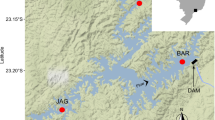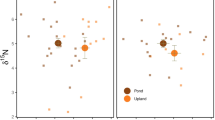Abstract
To date, studies of food overlap in Antarctic fish have been performed on a mixture of late juvenile and adult stages, leaving the young immature specimens (TL ≤ 10 cm) practically unexplored. We studied diet overlap and potential competition among early juvenile individuals in a coastal notothenioid community at Potter Cove, by analysing the stomach contents of 225 fish of 5 species collected in the summer of 2009–2010. We used frequency of occurrence (F %) and the coefficient “Q” for diet evaluation and the method of Tyler and the similarity index “S” for food overlap. Amphipods of the suborder Gammaridea were the main (Q > 2.900) and most frequent (% F) prey for all species, although Notothenia coriiceps also consumed gastropods of the family Littorinidae, mostly Laevilitorina antarctica. Secondary prey were algae for Notothenia rossii and N. coriiceps, calanoid (pelagic) and harpacticoid (benthic) copepods for Trematomus newnesi and the latter copepods and isopods of the family Munnidae for Lepidonotothen nudifrons. The reoccurrence of prey among fish species was 39.6 % and food overlap between 90 % of species pairs was under 58 %. Because similarly low values of diet overlap were reported for intermediate/advanced juveniles and adults of the same species at the same site, we conclude that there is no difference in the degree of interspecific food overlap and therefore potential competition between the immature and mature fraction of the fish community. Food competition is avoided by resource partitioning along a depth gradient or by different prey species.



Similar content being viewed by others
References
Arntz WE (1980) Predation by demersal fish and its impact on the dynamics of macrobenthos. In: Tenore KR, Coull BC (eds) Marine benthic dynamics. University of South Carolina Press, Columbia, pp 121–149
Atkinson EG, Percy JA (1992) Diet comparison among demersal marine fish from the Canadian Arctic. Polar Biol 11:567–573
Barrera-Oro ER (2002) The role of fish in the Antarctic marine food web: differences between inshore and offshore waters in the southern Scotia Arc and west Antarctic Peninsula. Antarct Sci 14:293–309
Barrera-Oro ER (2003) Analysis of dietary overlap in Antarctic fish (Notothenioidei) from the South Shetland Islands: no evidence of food competition. Polar Biol 26:631–637
Barrera-Oro ER, Casaux RJ (1990) Feeding selectivity in Notothenia neglecta, Nybelin, from Potter Cove, South Shetland Islands, Antarctica. Antarct Sci 2:207–213
Barrera-Oro ER, Casaux R (2008) General ecology of coastal fish from the South Shetland Island and west Antarctic Peninsula areas. Beri Polar und Meeresforsch 571:95–110
Barrera-Oro ER, Piacentino GLM (2007) Feeding habits of juvenile Trematomus newnesi (Pisces, Nototheniidae) at Potter Cove, South Shetland Islands, Antarctica. Polar Biol 30:789–796
Barrera-Oro ER, Winter D (2008) Age composition and feeding ecology of early juvenile Notothenia rossii (Pisces, Nototheniidae) at Potter Cove, South Shetland Islands, Antarctica. Antarct Sci 20:339–341
Casaux RJ (1998) The contrasting diet of Harpagifer antarcticus (Notothenioidei, Harpagiferidae) at two localities of the South Shetland Islands, Antarctica. Polar Biol 19:283–285
Casaux R, Mazzotta A, Barrera-Oro ER (1990) Seasonal aspects of the biology and diet of nearshore nototheniid fish at Potter Cove, South Shetland Islands, Antarctica. Polar Biol 11:63–72
Daniels RA (1982) Feeding ecology of some fishes of the Antarctic Peninsula. Fish Bull 80:575–588
Eastman JT, Barrera-Oro ER (2010) Buoyancy studies of three morphs of the Antarctic fish Trematomus newnesi (Nototheniidae) from the South Shetland Islands. Polar Biol 33:823–831
Everson I (1977) The living resources of the Southern Ocean. GLO/SO/77/1. FAO, Rome
Gon O, Heemstra PC (eds) (1990) Fishes of the Southern Ocean. JLB Smith Institute of Ichthyology, Grahams Town
Gon O, Mostert D (1992) Aspects of the ecology of two nototheniid fish species in the inshore zone of the sub-Antarctic Marion Island. South Afr J Antarct Res 22:59–67
Gröhsler T (1994) Feeding habits as indicators of ecological niches: investigations of Antarctic Fish conducted near Elephant Island in late autumn/winter 1986. Arch Fish Mar Res 42:17–34
Hoeines AS, Bergstad OA (2002) Food partitioning by flatfish species on a herring spawning ground. Sarsia 87:19–34
Hureau JC (1970) Biologie comparée de quelques Poissons antarctiques (Nototheniidae). Bull Inst Oceanogr Monaco 68:1–244
Iken K, Barrera-Oro ER, Quartino ML, Casaux RJ, Brey T (1997) Grazing by the Antarctic fish Notothenia coriiceps: evidence for selective feeding on macroalgae. Antarct Sci 9:386–391
Klemetsen A (1993) The food of the long-rough dab (Hippoglossoides platessoides limandoides Bloch) in Balsfjorden, north Norway. Sarsia 78:17–24
Kock K-H, Kellermann A (1991) Reproduction in Antarctic notothenioid fish (review). Antarct Sci 3:125–150
Kock K-H, Barrera-Oro E, Belchier M, Collins MA, Duhamel G, Hanchet S, Pshenichnov L, Welsford D, Williams R (2012) The role of fish as predators of krill (Euphausia superba) and other pelagic resources in the southern ocean. CCAMLR Sci 19:115–169
La Mesa M, Vacchi M, Castelli M, Diviacco G (1997) Feeding ecology of two nototheniid fishes, Trematomus hansoni and Trematomus loennbergii, from Terra Nova Bay, Ross Sea. Polar Biol 17:62–68
Linton LR, Davies RW, Wrona FJ (1981) Resource utilization indices: an assessment. J Anim Ecol 50:283–292
Moreno CA, Bahamonde N (1975) Nichos alimentarios y competencia por el alimento entre Notothenia coriiceps neglecta Nybelin y Notothenia rossii marmorata Fischer en Shetland del Sur, Antártica. Ser Cient Inst Antárt Chil 3:45–62
Murie DJ (1995) Comparative feeding ecology of two sympatric rockfish congeners, Sebastes caurinus (copper rockfish) and S. maliger (quillback rockfish). Mar Biol 124:341–353
Odum EP (1971) Fundamentals of Ecology. W.B Saunders Company, Piladelphia 574 pp
Quartino ML, Boraso de Zaixso AL (2008) Summer macroalgal biomass in Potter Cove, South Shetland Islands, Antarctica: its production and flux to the ecosystem. Polar Biol 31:281–294
Rakusa-Suszczewski S, Piasek A (1973) Size, feeding and action of proteolytic enzymes in the Antarctic fish of the Trematomus genus (Nototheniidae). Bull Pol Acad Sci Biol Sci Ser 21:139–144
Schwarzbach W (1988) The demersal fish fauna of the eastern and southern Weddell Sea: geographical distribution, feeding of fish and their trophic position in the food web. Ber Polarforsch 5:1–94
Takahashi M, Iwami T (1997) Summer diet of demersal fish at the South Shetland Islands. Antarct Sci 9:407–413
Targett TE (1981) Trophic ecology and structure of coastal Antarctic fish communities. Mar Ecol Prog Ser 4:243–263
Tyler AV (1972) Food resource division among northern, marine demersal fishes. J Fish Res Board Can 29:997–1003
Vacchi M, La Mesa M, Castelli A (1994) Diet of two coastal nototheniid fish from Terra Nova Bay, Ross Sea. Antarct Sci 6:61–65
Wiencke C, Ferreyra G, Arntz W, Rinaldi C (1998) The Potter Cove coastal ecosystem, Antarctica—Synopsis of research performed within the frame of the Argentinean–German Cooperation at the Dallmann Laboratory and Jubany Station (King George Island, Antarctica, 1991–1997). Ber Polarforsch 299:1–326
Wiencke C, Ferreyra GA, Abele D, Marenssi S (2008) The Antartic ecosystem of Potter Cove, King- George Island (Isla 25 de Mayo). Synopsis of research performed 1999-2006 at the Dallmann Laboratory and Jubany Station. Ber Polarforsch Meeresforsch 571:1–411
Acknowledgments
We thank Carlos Bellisio, Luis Vila and Oscar González, members of the Instituto Antártico Argentino for their field assistance. We are grateful to Drs. G. Alonso, J. Lopez Gappa, M. Landoni, and L. Quartino, and Lic. G. Campana and Lic. D. Deregibus helped with prey identification. We thank Dr. M. La Mesa, Prof. J. Eastman and an anonymous referee, whose critical comments improved the quality of this paper.
Author information
Authors and Affiliations
Corresponding author
Rights and permissions
About this article
Cite this article
Moreira, E., Juáres, M. & Barrera-Oro, E. Dietary overlap among early juvenile stages in an Antarctic notothenioid fish assemblage at Potter Cove, South Shetland Islands. Polar Biol 37, 1507–1515 (2014). https://doi.org/10.1007/s00300-014-1545-3
Received:
Revised:
Accepted:
Published:
Issue Date:
DOI: https://doi.org/10.1007/s00300-014-1545-3




